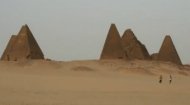|
Nubian Desert |
Nubian Desert |
Nubian Desert | Nubian Desert |

|
Despite its harshness, the Nubian Desert is far from barren in terms of history and human connection. For millennia, it served as a vital, albeit perilous, bridge between the ancient civilizations of Egypt to the north and the rich kingdoms of Nubia (such as Kerma, Napata, and Meroe) to the south, and further into sub-Saharan Africa. Ancient trade routes, including the fabled Darb el-Arbain (Forty Days Road), crisscrossed its formidable expanses, facilitating the exchange of gold, ivory, spices, precious stones, and enslaved people. Evidence of these routes, including ancient wells, rock carvings (petroglyphs) depicting animals and human figures, and stone markers, can still be found by those who venture deep into its heart.On the outskirts of the Nubian desert can be found the Pyramids of Meroe, near to the bank of the River Nile. There are around two hundred and fifty of these pyramids constructed from the desert sandstone. They are the ancient burial places of the Kingdom of Kush (1000 BCE to 350 CE), dating back to around 800 years after the construction of the last Egyptian pyramids which are much larger in size. The indigenous people of this region, the Nubians, have a deep-rooted cultural heritage tied to the Nile and the desert fringes. Their ancient kingdoms flourished along the river, often engaging in complex interactions, both peaceful and conflictual, with their Egyptian neighbors. The desert also held significant mineral wealth, particularly gold, which was extensively mined by ancient Egyptians and Nubians alike, contributing to the prosperity of their empires. In contemporary times, the Nubian Desert remains sparsely populated. Small nomadic groups and prospectors continue to brave its conditions, and modern gold mining operations, both artisanal and industrial, have seen a resurgence in parts of Sudan. The construction of the Aswan High Dam in the 1960s flooded vast stretches of historical Nubia, creating Lake Nasser, which stretches deep into the desert and altered the landscape, displacing many Nubian communities, some of whom were resettled in desert towns. The Nubian Desert's most recent claim to fame is that it was the landing place of asteroid 2008 TC3 which exploded creating a fireball as bright as the moon. Fragments of the asteroid have been recovered and are currently being investigated at the Carnegie Institution's Geophysical Laboratory. |








